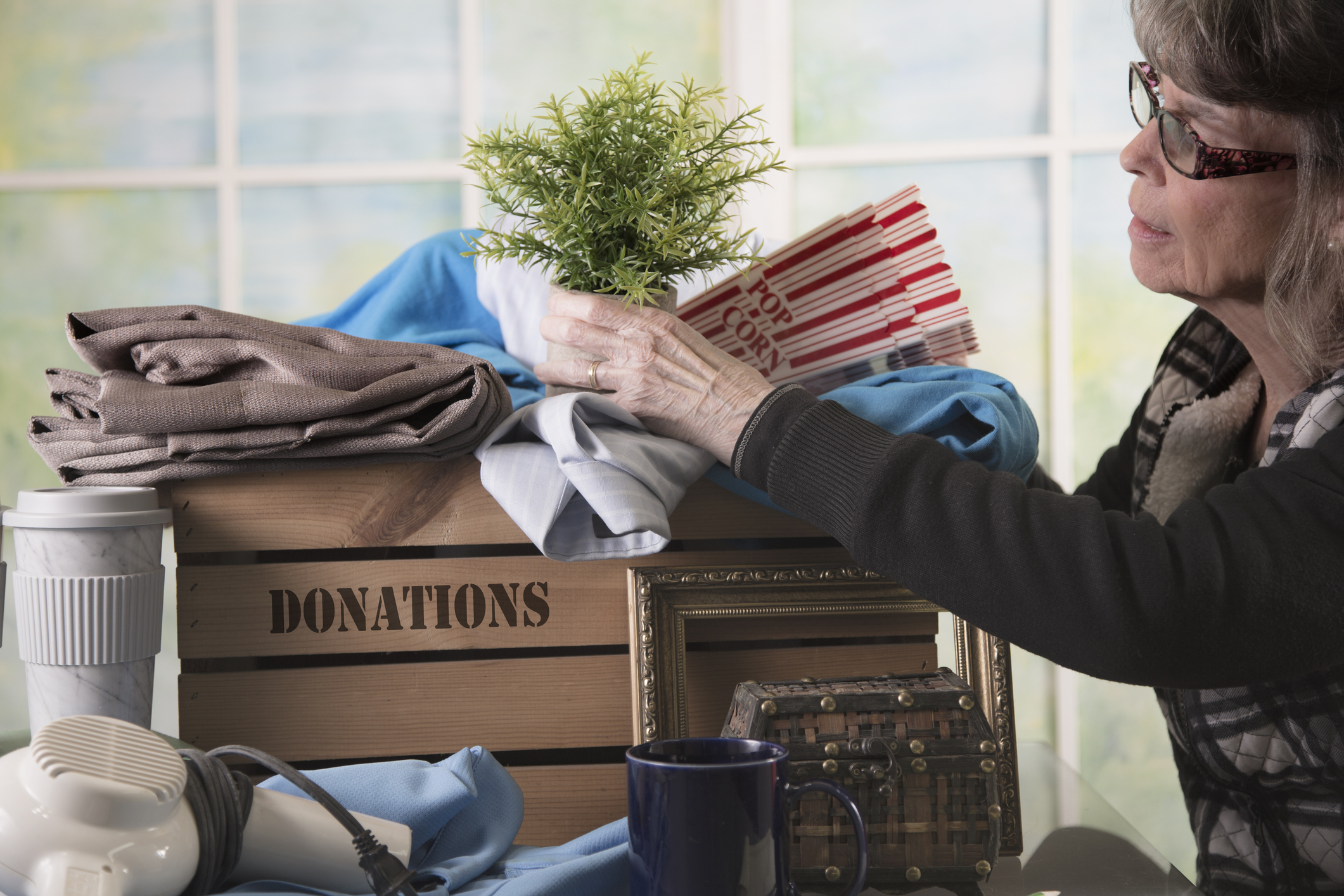Decluttering Tips to Get a Head Start on Downsizing
Strategies include starting small, adopting a system, getting help from others and being ruthless about what to keep, even when it comes to sentimental items or inherited possessions.


When I retired as editor of Kiplinger Personal Finance Magazine, one of the things at the top of my to-do list was to clean out my closets and get rid of other assorted stuff that had accumulated over decades. Now, eight years later, I have to admit that I’ve made only modest progress.
I’ve made at least one pass at all the closets, given away much of my work-era wardrobe and handed off to my now-grown kids all their old school papers. Yet somehow the closets are still full, the books seem to have regenerated on the shelves, and I don’t even want to think about the pre-cell phone photographs.
I’m not planning to move anytime soon, but I sought advice from downsizing specialists on how to get a head start on paring back my possessions.
From just $107.88 $24.99 for Kiplinger Personal Finance
Become a smarter, better informed investor. Subscribe from just $107.88 $24.99, plus get up to 4 Special Issues

Sign up for Kiplinger’s Free Newsletters
Profit and prosper with the best of expert advice on investing, taxes, retirement, personal finance and more - straight to your e-mail.
Profit and prosper with the best of expert advice - straight to your e-mail.
Tops on their list is to keep your emotions out of it.
“Start in a small space without a lot of sentimental value, like a bathroom or linen closet,” advises Mary Kay Buysse, co-executive director of the National Association of Senior Move Managers. “By the time you build up to a chest of drawers or bookshelves, you’ve established a rhythm, and you’re ready for bigger jobs with more emotional investment.”
Also important: Adopt a system that works for you. Instead of attacking your closet a few pieces at a time, Buysse recommends that you empty the whole closet and then start putting things back.
If that sounds overwhelming, another option is to “be constantly editing your things,” says Marni Jameson, author of Downsizing the Family Home. “The whole process of thinning out your closets and your home should be a lifestyle, like putting money into your 401(k).”
Jameson keeps a giveaway bag in her closet and a box in the garage, and she tosses things in as she goes along.
Leah Friedman, a professional organizer and executive consultant, recommends inviting a friend or hiring an organizer to help as you sort through your stuff.
“Getting someone else involved will push you harder, like having a personal trainer,” Friedman says. “And it can help make an emotionally draining task more fun.”
Don’t count on your kids
“They don’t want a darn thing,” says Buysse, especially big brown furniture, dining room sets and TV armoires. “By the time older adults pass away, their children are often in their 50s and have everything they could possibly need.”
Bottom line: Be ruthless. “There’s no ‘maybe’ pile,” says Buysse. “There’s a ‘keep’ and a ‘go.’ ” A “maybe” pile will trip you up every time, she says, because you put off making a decision and potentially end up spending thousands of dollars on a storage locker.
Buysse recommends the one-year rule, which is a standard in her field: If you haven’t worn it or used it within a year, it’s a candidate for the “go” pile.
Jameson advises asking yourself whether you would buy an item again. “Don’t keep something because so-and-so gave it to you or because it was expensive.”
Apply the same tough standards to things you may have inherited from your own parents. “Don’t feel guilty about donating Grandma’s china,” says Friedman. “You’re not donating Grandma. It’s just her china.”
When you do plan to downsize, it’s time to shift into overdrive. Don’t even try to squeeze all of your things into a smaller space. Instead, measure your new space and start from scratch.
“If you have to cut back from 12 kitchen cabinets to two, figure out what goes into those two cabinets,” says Buysse.
In the meantime, enjoy the feeling of freedom that comes with shedding superfluous stuff. “I believe you can de-stress if you get down to ground zero in your home,” says Friedman. “If you want to sleep better, have nothing under the bed.”
Got any decluttering tips you’d like to share? Just let me know.
Note: This item first appeared in Kiplinger Personal Finance Magazine, a monthly, trustworthy source of advice and guidance. Subscribe to help you make more money and keep more of the money you make here.
Related Content
Profit and prosper with the best of Kiplinger's advice on investing, taxes, retirement, personal finance and much more. Delivered daily. Enter your email in the box and click Sign Me Up.

Janet Bodnar is editor-at-large of Kiplinger's Personal Finance, a position she assumed after retiring as editor of the magazine after eight years at the helm. She is a nationally recognized expert on the subjects of women and money, children's and family finances, and financial literacy. She is the author of two books, Money Smart Women and Raising Money Smart Kids. As editor-at-large, she writes two popular columns for Kiplinger, "Money Smart Women" and "Living in Retirement." Bodnar is a graduate of St. Bonaventure University and is a member of its Board of Trustees. She received her master's degree from Columbia University, where she was also a Knight-Bagehot Fellow in Business and Economics Journalism.
-
 The SEC Is Concerned for Older Investors and Retirement Savers. Here's What You Should Know
The SEC Is Concerned for Older Investors and Retirement Savers. Here's What You Should KnowThe SEC focusing on older investors, retirement and college savers, and private securities. Here's how those changes impact you.
-
 Vesting, Catch-Ups and Roths: The 401(k) Knowledge Quiz
Vesting, Catch-Ups and Roths: The 401(k) Knowledge QuizQuiz Test your understanding of key 401(k) concepts with our quick quiz.
-
 Why You Should Pay Attention to Company Guidance
Why You Should Pay Attention to Company GuidanceUnderstanding how corporate profit forecasts affect analysts’ estimates and stock ratings can help you make investment decisions.
-
 Vesting, Catch-Ups and Roths: The 401(k) Knowledge Quiz
Vesting, Catch-Ups and Roths: The 401(k) Knowledge QuizQuiz Test your understanding of key 401(k) concepts with our quick quiz.
-
 The 2026 Retirement Catch-Up Curveball: What High Earners Over 50 Need to Know Now
The 2026 Retirement Catch-Up Curveball: What High Earners Over 50 Need to Know NowUnlock the secrets of the 2026 retirement catch-up provisions: A must-read for high earners aged 50 and above.
-
 A 5-Step Plan for Parents of Children With Special Needs, From a Financial Planner
A 5-Step Plan for Parents of Children With Special Needs, From a Financial PlannerGuidance to help ensure your child's needs are supported now and in the future – while protecting your own financial well-being.
-
 I'm 59 With $1.7 Million Saved and Just Lost My Job. Should I Retire at 59½, or Find New Work?
I'm 59 With $1.7 Million Saved and Just Lost My Job. Should I Retire at 59½, or Find New Work?We asked professional wealth planners for advice.
-
 A Wealth Adviser Explains: 4 Times I'd Give the Green Light for a Roth Conversion (and 4 Times I'd Say It's a No-Go)
A Wealth Adviser Explains: 4 Times I'd Give the Green Light for a Roth Conversion (and 4 Times I'd Say It's a No-Go)Roth conversions should never be done on a whim — they're a product of careful timing and long-term tax considerations. So how can you tell whether to go ahead?
-
 A 4-Step Anxiety-Reducing Retirement Road Map, From a Financial Adviser
A 4-Step Anxiety-Reducing Retirement Road Map, From a Financial AdviserThis helpful process covers everything from assessing your current finances and risks to implementing and managing your personalized retirement income plan.
-
 I Drive and Collect Classic Cars: Here’s How I Got in the Game Without Spending a Fortune
I Drive and Collect Classic Cars: Here’s How I Got in the Game Without Spending a FortuneAre classic cars a hobby or an investment strategy — or both? Either way, the vintage car scene is much cooler and more affordable than you think.
-
 The $183,000 RMD Shock: Why Roth Conversions in Your 70s Can Be Risky
The $183,000 RMD Shock: Why Roth Conversions in Your 70s Can Be RiskyConverting retirement funds to a Roth is a smart strategy for many, but the older you are, the less time you have to recover the tax bite from the conversion.